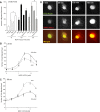Macrophage migration arrest due to a winning balance of Rac2/Sp1 repression over β-catenin-induced PLD expression
- PMID: 23898047
- PMCID: PMC3800072
- DOI: 10.1189/jlb.0313174
Macrophage migration arrest due to a winning balance of Rac2/Sp1 repression over β-catenin-induced PLD expression
Abstract
Monocytes and neutrophils infiltrate into tissues during inflammation and stay for extended periods of time until the initial insult is resolved or sometimes remain even longer in the case of chronic inflammation. The mechanism as to why phagocytes become immobilized after the initial cell migration event is not understood completely. Here, we show that overexpression or hyperactivation of Rac2 decreases sustained chemotactic responses of macrophages to MCP-1/CCL2. The resulting leukocyte arrest is not caused by a diminished availability of the cytokine receptor CCR2 that remains intact during MCP-1 stimulation. We show a novel mechanism that links the Rac2-dependent arrest of chemotaxis to decreased expression of PLD2 through the transcription regulator Sp1. Prolonged Rac2 activity leads to nuclear overactivation of Sp1, which acts as a repressor for PLD2. Also, another signaling component plays a regulatory role: β-catenin. Although early times of stimulation (≈ 20 min) with MCP-1/CCL2 resulted in activation of β-catenin with a positive effect on PLD2, after ≈ 3 h of stimulation, the levels of β-catenin were reduced and not able to prevent the negative effect of Rac2 on PLD2 activity. This is a novel molecular mechanism underlying immobilization of monocyte/macrophage migration that is important for the physiological maintenance of leukocytes at the site of inflammation. If this immobilization is prolonged enough, it could lead to chronic inflammation.
Keywords: cell migration; chemotaxis; gene expression regulation; granulocyte; monocyte signaling cascade.
Figures






Similar articles
-
The dual effect of Rac2 on phospholipase D2 regulation that explains both the onset and termination of chemotaxis.Mol Cell Biol. 2011 Jun;31(11):2227-40. doi: 10.1128/MCB.01348-10. Epub 2011 Mar 28. Mol Cell Biol. 2011. PMID: 21444720 Free PMC article.
-
The mechanism of cell membrane ruffling relies on a phospholipase D2 (PLD2), Grb2 and Rac2 association.Cell Signal. 2011 Aug;23(8):1291-8. doi: 10.1016/j.cellsig.2011.03.010. Epub 2011 Mar 16. Cell Signal. 2011. PMID: 21419846 Free PMC article.
-
Rac1 and Rac2 regulate macrophage morphology but are not essential for migration.J Cell Sci. 2006 Jul 1;119(Pt 13):2749-57. doi: 10.1242/jcs.03024. Epub 2006 Jun 13. J Cell Sci. 2006. PMID: 16772332
-
Monocytes and dendritic cells in a hypoxic environment: Spotlights on chemotaxis and migration.Immunobiology. 2008;213(9-10):733-49. doi: 10.1016/j.imbio.2008.07.031. Epub 2008 Sep 21. Immunobiology. 2008. PMID: 18926289 Review.
-
Biochemical and cellular implications of a dual lipase-GEF function of phospholipase D2 (PLD2).J Leukoc Biol. 2012 Sep;92(3):461-7. doi: 10.1189/jlb.0212073. Epub 2012 Jul 2. J Leukoc Biol. 2012. PMID: 22750546 Free PMC article. Review.
Cited by
-
A river runs through it: how autophagy, senescence, and phagocytosis could be linked to phospholipase D by Wnt signaling.J Leukoc Biol. 2014 Nov;96(5):779-84. doi: 10.1189/jlb.2VMR0214-120RR. Epub 2014 Jul 31. J Leukoc Biol. 2014. PMID: 25082152 Free PMC article. Review.
-
Identification and validation of genes related to stem cells and telomere maintenance mechanisms as biomarkers for breast cancer.Front Immunol. 2025 Jul 1;16:1618193. doi: 10.3389/fimmu.2025.1618193. eCollection 2025. Front Immunol. 2025. PMID: 40666524 Free PMC article.
-
Fibroblast activation protein protects bortezomib-induced apoptosis in multiple myeloma cells through β-catenin signaling pathway.Cancer Biol Ther. 2014 Oct;15(10):1413-22. doi: 10.4161/cbt.29924. Epub 2014 Jul 21. Cancer Biol Ther. 2014. PMID: 25046247 Free PMC article.
-
Enhanced Integrin Activation of PLD2-Deficient Platelets Accelerates Inflammation after Myocardial Infarction.Int J Mol Sci. 2020 May 1;21(9):3210. doi: 10.3390/ijms21093210. Int J Mol Sci. 2020. PMID: 32370031 Free PMC article.
-
Phospholipase D in cell signaling: from a myriad of cell functions to cancer growth and metastasis.J Biol Chem. 2014 Aug 15;289(33):22557-22566. doi: 10.1074/jbc.R114.574152. Epub 2014 Jul 2. J Biol Chem. 2014. PMID: 24990944 Free PMC article. Review.
References
-
- Koshland D. E. (1982) Special topic: chemotaxis and motility. Annu. Rev. Physiol. 44, 499–500
-
- Ridley A. J., Schwartz M. A., Burridge K., Firtel R. A., Ginsberg M. H., Borisy G., Parsons J. T., Horwitz A. R. (2003) Cell migration: integrating signals from front to back. Science 302, 1704–1709 - PubMed
-
- Vicente-Manzanares M., Webb D. J., Horwitz A. R. (2005) Cell migration at a glance. J. Cell Sci. 118, 4917–4919 - PubMed
-
- Luster A. D., Alon R., von Andrian U. H. (2005) Immune cell migration in inflammation: present and future therapeutic targets. Nat. Immunol. 6, 1182–1190 - PubMed
Publication types
MeSH terms
Substances
Grants and funding
LinkOut - more resources
Full Text Sources
Other Literature Sources
Molecular Biology Databases
Miscellaneous

